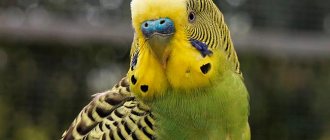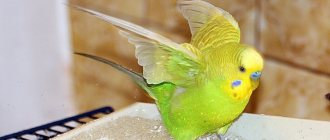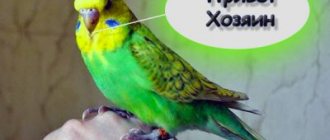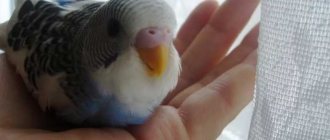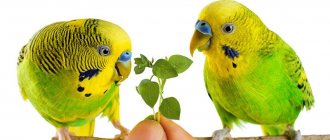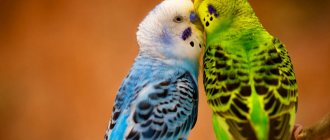Many people keep budgies at home - their care is minimal, but the emotional return is enormous. Before buying, the future owner thinks about how to choose the best budgie: healthy, young, and able to talk. After reading the article, you will learn about all the subtleties: what questions to solve initially, what places sell good birds, what a budgie should look like. And the last thing is what you need to do when you take your baby home, how to help him survive the adaptation.
How to prepare to buy a parrot
Getting a small parrot is as easy as shelling pears: now pet stores are full of different birds, food, and accessories for keeping them. The prices for all this stuff are affordable. Before you start choosing a parrot for your home, you need to think things through. It’s worth discussing your wishes with your family and not forgetting a single detail:
- Watch the video. Even little ones like wavy creatures litter and make noise. They wake up at dawn and chirp all day. Flying around the apartment, they leave droppings behind them, tear off wallpaper and curtains. They spoil documents, books, gnaw flowers.
- Evaluate the space. Select the location where the cage will be located. The wavy does not need a large home, but it still needs freedom. The maintenance rules stipulate that the cage should be kept away from windows, batteries and household appliances. At the same time, parrots do not like to be moved from place to place. Birds should have a permanent corner.
- Make time. Sociable birds require attention; they get bored without people. If you don't have even one free hour a day to talk to, pet, and train your parrot, don't get a pet. Loneliness and then depression await him.
- Select the sex and number of birds. With plenty of time to spend, take one wavy boy. Males learn better and imitate speech. Females are shy and less attached to their owner. Two same-sex birds often quarrel, while opposite-sex birds create a family and raise chicks.
- Collect a first aid kit. It’s not enough just to provide care items and medications; you also need to write down the address and telephone number of the nearest veterinary clinic. The feathered ward will have to be treated, vaccinated, and taken for preventive examinations.
Attention! The down and feathers of budgies provoke an allergic reaction. If anyone in your family is prone to allergies, do not buy the bird.
When all the pros and cons are weighed, and the decision is made that you are buying wavy, it’s time to go to the trading places.
Determining gender by behavior
Plumage color and other external characteristics help determine gender if you study the specific variety well. By behavior, you can distinguish a male from a female bird of any breed. So, girls are usually calmer, like to nap, relax, and it is difficult to interest them in a mirror, bell and other toys. They do not like to sit on hands, they get irritated when the owner tries to pet or scratch them, and they can bite the owner’s finger until it bleeds. Ladies do not respond to human conversation, are poorly trained and are considered more wild and aggressive. In nature, females hollow out hollows in which they raise chicks, so their genes contain a constant desire to gnaw on something, for example, a cage or a perch.
Boys are usually more good-natured by nature. They easily get used to being handled, love to play, chirp, and they like to communicate with their reflection in the mirror. Males respond well to human voices and always prefer to carry on a conversation. If the look is speaking, then the guy will begin to repeat words faster than his partner. These are friendly, tame animals that happily sit in their owner’s arms.
You can tell the difference between a boy and a girl by observing the behavior of the couple. Males often place their paw on their cagemate. If a boy and a girl are kept together, the boy will feed his girlfriend by regurgitating food into her beak. During sexual intercourse, boys are always on top and girls are on bottom. Often in the behavior of the male one can observe an imitation of sexual intercourse with other objects. Some ladies also exhibit similar behavior, but not so often
In most species, during the mating season, it is the male who tries to attract the attention of his beloved. He dances, demonstrates the beauty of his plumage and his vocal abilities
You can determine the sex of a feathered pet by its sitting style. For example, girls sit on a perch with their paws widely spaced, as if placing their belly on the perch. Boys usually move their paws tightly together when sitting. This sign can be observed when the parrot reaches one year of age.
Where to buy a budgie
You can buy a budgie from amateur breeders or at retail outlets:
- in a pet store;
- from a professional breeder;
- by advertisement;
- in a specialized club;
- at the poultry market.
Buying a budgie from a pet store is the easiest option. There are always birds of different colors there. Usually chicks bred at home are sold there. The seller will help you figure out how to choose the right pet parrot. He will tell you about the needs of the bird and recommend equipment. Conscientious traders value the store's reputation and take good care of the birds and do not allow the cages to become overcrowded. If you're lucky, the seller will recommend an individual that's right for you.
A breeder is a person who breeds birds professionally. He knows thoroughly the positive and negative sides of the chick, and can tell everything about health, behavior and possible problems. He will show the parents, name their age and gender. Often, breeders monitor the fate of sold parrots and offer their phone number for consultation.
Attention! When buying a bird from an advertisement, you risk getting a sick, old or malignant bird with which the previous owners did not get along.
In specialized nurseries and clubs, chicks with interesting colors or show ones are often chosen. Here you will find out the exact age of the bird and its origin. Such parrots have a pedigree, a permanent ring, and a corresponding price.
The poultry market should be considered last. In such places, birds live in cramped conditions and dirt. They are poorly cared for due to the huge number of individuals. In such conditions, you may unexpectedly buy a sick parrot. In order not to take a “pig in a poke,” you need to know the signs of a painful condition and imagine the appearance of a healthy wavy.
Content Features
The process of caring for two birds is significantly different from caring for one individual.
The main features include:
a spacious cage is purchased, equipped with the necessary elements, which include toys, perches, drinkers and feeders;- It is advisable to buy rectangular cages, since cubic, round or cylindrical products create difficulties for the birds’ orientation;
- approximately 1.5 cm is left between the rods;
- Be sure to buy 2 mineral stones, which act as a source of minerals for pets;
- To feed budgies, specialized grain feeds are selected, and it is also advisable to add fruits and vegetables;
- It is allowed to periodically delight the birds with boiled eggs or cottage cheese.
Parrots should always have access to clean, fresh water.
What does a healthy bird look like?
A sick parrot is not as scary as you might think. But you cannot bring a sick individual into a house where other birds live - it will infect everyone. So how to choose and buy a healthy parrot? Carefully consider his appearance and behavior. Indicators of a successful bird:
- shiny, dense plumage;
- eyes are clean, not cloudy;
- cere without cracks and growths;
- smooth, clean beak;
- smooth skin on the paws;
- proud posture;
- The cloaca area is neat, covered with feathers.
A well-groomed parrot should be well-fed and active. When sitting on a perch, the paws are spread wide and grasp firmly with four toes. If there have been injuries, fractures, the bird has difficulty maintaining its balance and walks awkwardly.
What is the difference between a chick and an adult?
Ornithologists recommend choosing a budgerigar no older than six months. The growing chick has a flexible psyche, it is easier to tame, and quickly gets used to its new home. In order for your parrot to speak, you need to start training it as early as possible. How to avoid making a mistake with age when purchasing?
Signs of young individuals:
- clear waves on the back and head from the cere. After the first molt, the feathers from the crown to the back of the head acquire one color, without inclusions or patterns;
- black spots on the beak, dark irises, without rings;
- short tail;
- matte shade of feathers, without shine.
You need to examine the bird in the company of relatives. By comparing different individuals, you are more likely to select a young parrot.
Signs of a young wavy
Young individuals can get used to new owners and living conditions. Signs of a young wavy:
- The young bird has black eyes
- Chicks have a black beak, a 2-3 month old chick has a black smear on its beak
- The juvenile has a short tail
- After 1.5 months, the bird’s feathers should lie tightly together
- At about a month of age, the chicks can already fly
- The cere of a young individual has a light blue tint
Although it is difficult to determine the age of a budgerigar, it is worth paying special attention to all of the above recommendations and signs of a healthy and active bird
How many parrots to buy
The number of birds depends on the goals and capabilities of the breeder. If you are choosing a companion who will brighten up your loneliness, it is better to take one talking parrot. Constant communication and care will allow the new pet to become a full member of the family over time. Connoisseurs of silence are advised to get a girl budgerigar, since females are less noisy than males.
If the owners are not home much, the lonely bird begins to feel sad. You can save your feathered ward from sadness by choosing company for him. Two or three individuals can live in one spacious cage. Well, if you have plans for breeding, buy a female and a male at once.
Attention! It is not advisable to buy two parrots in one place: a pair of opposite sexes may be from the same parents. Reproduction of closely related birds leads to degeneration of the breed and the appearance of offspring with developmental defects.
Dating nuances
As soon as a second pet is purchased, it needs to be kept in a separate cage for some time to undergo quarantine, and it lasts about a month. Such actions help prevent infection with any infectious disease.
Dating rules include:
- Initially, cages with parrots are installed next to each other so that they can see and hear each other;
- then you can let them fly around the room for a short time, but if they start to fight or quarrel, you will have to keep them in different rooms again;
- if the second acquaintance goes poorly, then a new parrot must be replaced;
- during the adaptation period, birds should not be frightened, so they are kept in a quiet and calm environment;
- if breeding is planned, then the pets are kept in one cage, so it should be quite large, and a nesting house should be installed inside;
- two drinkers and feeders are purchased, as well as many perches and toys to prevent fights.
If your parrot has lived alone for a long time, then the appearance of a pair is stressful for him, so you will have to prepare for difficult adaptation or even aggression on his part.
How to choose a male budgie
Male budgerigars are more often adopted: it is believed that they are more active, cheerful, and easier to tame. It is easier to teach a boy to speak, and the ability to imitate human speech is one of the most attractive qualities.
Often gender is quite obvious. Females and males do not differ particularly in plumage; the main external sexual characteristic is the color of the wax. In mature females it is brown or beige, in males it is purple. In young birds that have not gone through the molting stage, gender is diagnosed with low probability. Even the seller cannot always tell you exactly.
Note: a wavy boy can be recognized by observing his behavior. The male will sing a lot, shake his wings frequently, and sit on top of other birds.
Boy or girl: which gender is better?
Usually the young male is raised first.
- Firstly, he makes contact with the owner faster.
- Secondly, he can be taught to talk!
What gender should you choose a parrot?
Boys have much more ability in the conversational genre. When the bird acclimatizes and chirps the first human words, you can look for a couple for him. And it is better to do this from another breeder to eliminate the danger of family ties. Then the offspring will be born healthy.
How to distinguish the sex of small wavy birds? This is quite difficult, and you can’t do it without the help of a specialist. The color of the cere differs in females, but very slightly if these are young birds.
The differences can be found like this:
- In a boy up to three months old, the rough growth above the nose is light purple, slightly pinkish. After some time, the color becomes deeper, approaching blue. If the behavior is active, even within one day the shades may change.
- For the girl, almost everything is exactly the same, and only a trained eye can discern the thin white circles near the nostrils. As it matures, the cere will become beige or bluish, and the rims will be more distinguishable. When she is ready to reproduce, this growth darkens to brown.
How to find a talking parrot
Budgerigars are able to remember words that a person says and reproduce them without reference to the situation. What to look for and how to choose a budgie to talk to?
- Gender is important: boys learn faster and speak more willingly than girls.
- Good health - an active and cheerful bird is in the mood for chatter.
- The young chick becomes strongly attached to its owner and trusts him boundlessly.
- Individuals with natural colors are the most talkative. Rare mutations, especially albinos, have difficulty speaking.
- Weak chicks abandoned by their parents are the best students. Growing up under the care of a “nanny,” they absorb information and begin to speak early.
Gender, age, health are the main criteria for learning ability. Boys aged 8 - 10 months are ideal for training. It turns out that choosing a parrot to talk to is not so difficult. Affectionate treatment will help consolidate the results.
Which parrot should you not take?
There are certain points in the behavior of birds that should alert you. When choosing, pay special attention to the following nuances:
- discharge from the nostrils is a consequence of a cold, runny nose or serious illness;
- the parrot itches a lot not only with its beak, but also with its claws - there are parasites on the skin and feathers;
- chips on the beak and growths on the cere are health problems.
A moderately timid parrot is normal; the instinct of self-preservation makes it afraid of everything unfamiliar. But if a bird fights in horror when a person approaches the cage, this is how mental disorders manifest themselves. Such an individual is difficult or impossible to tame.
How to help a bird adapt
So, the budgie was selected, purchased and delivered to the apartment inside a carrier. Now you need to carefully move it into the prepared cage. To do this, place the portable box next to the cage and align both open doors. It is necessary to pay attention: you cannot catch the bird and move it to a permanent home. Don't let him fly freely around the room. Be patient, otherwise the frightened bird will not be able to trust you for a long time.
Upon entering the cage, the parrot will discover the amenities you have created: feeders, various climbing devices, and seats. At first, he will hide from prying eyes in containers. Place a grain mixture and fresh twigs in the feeders in advance so that a hungry baby has something to do.
For the first two weeks, do not walk your new pet, do not disturb him again, and clean up the cage less often. Let the chick get used to the environment, new sounds and objects, and people's voices. Do not allow pets into the room, protect the parrot from flashes of light, create a suitable microclimate. Address the wavy kindly, call him by name.
Noticing that your ward is showing friendliness, let him out for a walk. Before doing this, secure the room as much as possible, close the doors and windows. Normally, the adaptation period ends when the bird calmly sits on the shoulder or finger of its owner. After this, consider that contact has been established.
Choosing a budgie is an important and difficult task. With proper care, a small feathered pet will live with you for ten years or even more. Decide in advance how many birds you need, what gender and age. Go to a reputable breeder to ensure you get healthy parrots.
Habits and character of the male, in contrast to the female
Observing pets at home, you can notice behavior patterns that directly or indirectly indicate the sex of the birds. How can you tell a boy's parrot from a girl's parrot if you look closely at their habits?
The male is nimble, restless, talkative. If you hang a mirror in a cage, the boy will show off in front of his reflection and try to bully his imaginary opponent. Even the songs of budgerigars are different: in the male they are loud, complex, and drawn-out. During his walk, he flies a lot and explores every corner with interest. Emphasizes its dominant position, puts its paw on its cage neighbor. The boy parrot is more successful in mastering human speech; his onomatopoeia is better developed.
The female with a wavy pattern can be distinguished by her modest manners; she is quiet and economical - she likes to clean up the cage. She chirps more than sings, her voice is expressionless. There is almost no ability to learn, the cases of pronouncing words are very rare. In communication with a person he does not show initiative, but in his hands he behaves quietly. The released bird, after flying for a bit, takes an observation position.
Shyness and submissiveness do not guarantee that you will accurately know the gender of a parrot. Not all females have a balanced character. There are individuals that are distinguished by jealousy and aggression. They constantly quarrel with their neighbors, mostly female.


